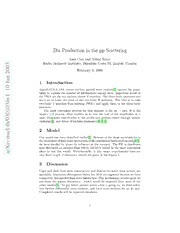
Eta Production in the pp Scattering PDF
Preview Eta Production in the pp Scattering
Eta Production in the pp Scattering Saˇsa Ceci and Alfred Sˇvarc - 3 Ruder Boˇskovi´c Institute, Bijeniˇcka Cesta 54, Zagreb, Croatia 0 0 February 8, 2008 2 n a 1 Introduction J 0 1 Zagreb-UCLA-ANL meson nucleon partial wave analysis[1] opened the possi- bility to explain the number of intermediate energy data. Important result of 1 the PWA are the eta nucleon elastic T matrices. The three-body processes can v 6 serve us to lower the error of the two-body T matrices. The idea is to take 3 two-body T matrices from existing PWA’s and apply them to the three-body 0 processes. 1 The most convenient process for that purpose is the pp → ppη. It is the 0 isospin 1/2 process, what enables us to test the half of the amplitudes at a 3 0 time. Dominant contribution to the production process comes through meson- / exchange[2], and decay of nucleon resonances[3, 4, 5]. h t - l 2 Model c u n Our model has been described earlier[3]. Because of the large uncertainties in : v thetreatmentoffinalstateinteractionoftheconsideredtheoreticalmodels[4,5], i we have decided to ignore its influence at the moment. The FSI is significant X near threshold, so energies from 100 to 500 MeV would be the most convenient r a place to test this model. Unfortunately, in this range, experimental data are very hard to get. Preliminary results are given in the Figure 1. 3 Discussion Light and dark lines show constructive and destructive total cross section, re- spectably. EnormousdiscrepancybelowfewMeVareexpectedbecausewehave completelydisregardedfinalstateinteraction. Ourpreliminaryresultsagaindo not show rho meson dominance - which would be expected from most of the other models[5]. To get better picture about what is going on, we shall calcu- late further differential cross sections, and total cross sections for pn to ηpn. Completed results will be reported elsewhere. 1 0.1 0.5 1 5 10 50 100 5001000 1mb F p+ h + r S 100µb I p- h + r IS 10µb s I tot H n P ctio 1µb IS W e I s ss 100nb 0. 1 0.5 1 5 1 0 50100 5 0 0 1 000 cro 100µb total 101nnbb FSI total cross section 11 110010 1000µµnnpn bbbbbb phr 100pb S11 o n ly 1 10pp bb 0. 1 0.5 1 5 1 0 50 1 0 0 5 0 0 1 0s 0 0tot excess energy [MeV] 10pb 0.1 0.5 1 5 10 50 100 5001000 excess energy [MeV] Figure 1: Experimental data are from [6]. Figure shows, qualitatively, not bad behavior of constructive sum of π and η contributions. Moreover, added correctionsofinitialandfinalinteractionwillpushtheoreticalcurveintheright direction. In the small graph is given contributions for each considered meson exchange. References [1] Batini´c, M. et al: Phys. Rev. C 81, 2310 (1995). Batini´c, M. et al: Physica Scripta 58, 15 (1998). [2] Machleidt R.: Adv. Nucl. Phys. 19, 189 (1989). [3] Batini´c, M., Sˇvarc, A. and Lee, T.-S. H.: Physica Scripta 56, 321 (1997). [4] Vetter,T.,Engel,A.,Bir´o,T.andMosel,U.: Phys. Lett.B263,153(1991). [5] Laget, J. M. and Wellers, F.: Phys. Lett. B 657, 254 (1991). Gedalin, E., Moalem, A. and Razdolskaja, L.: Nucl. Phys. A 634, 368 (1998). Santra, A. B. and Jain, B. K.: Nucl. Phys. A 634, 309 (1998). Hanhart, C. and Nakayama, K.: Phys. Lett. B 454, 176 (1999). [6] Cal´en, H. et al: Phys. Lett. B 458, 190 (1999). Moskal, P. et al: Phys. Lett. B 482, 356 (2000). 2
